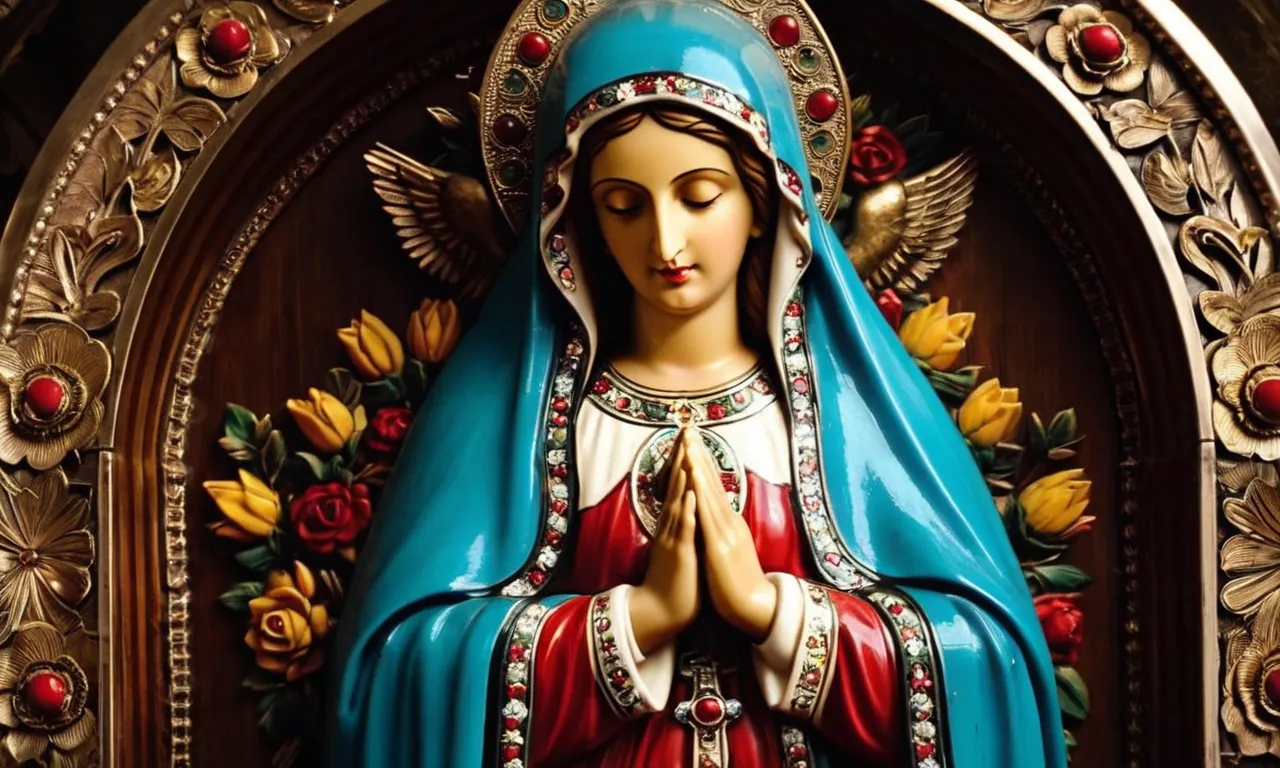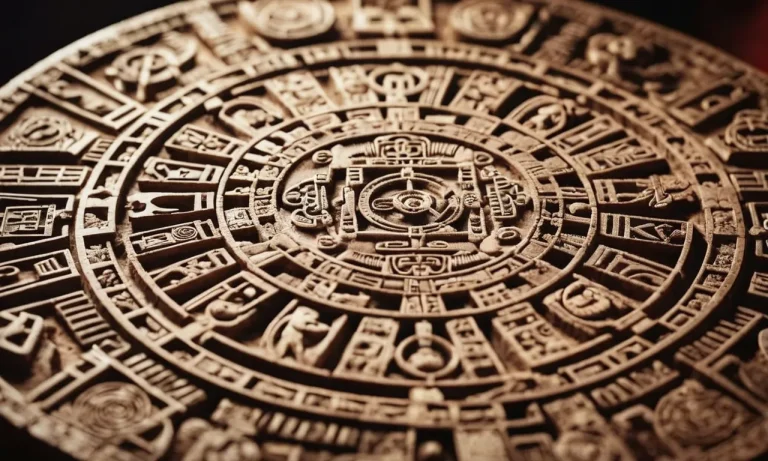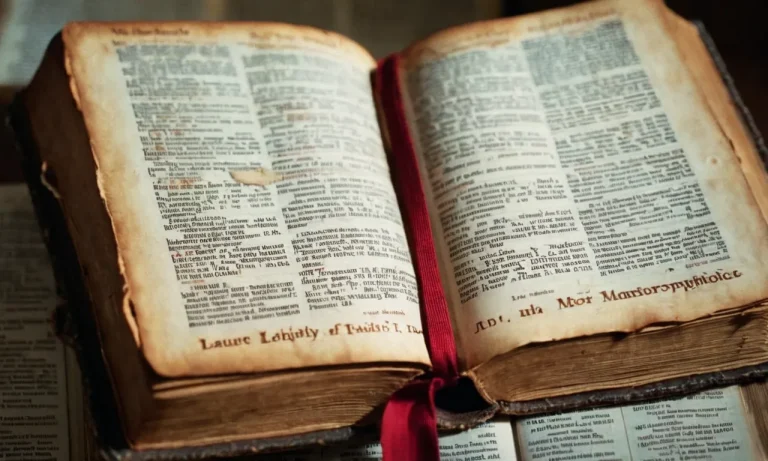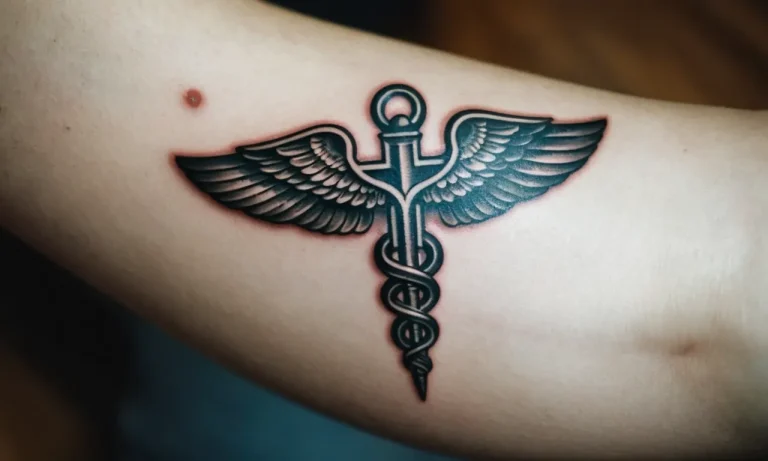Virgen De Guadalupe Tattoo Meaning: Exploring The Symbolism And Cultural Significance
The Virgen de Guadalupe, also known as Our Lady of Guadalupe, is a revered Catholic icon deeply rooted in Mexican culture and tradition. Her image, adorned on countless churches, altars, and even tattoos, holds profound spiritual and cultural significance.
If you’re short on time, here’s a quick answer to your question: A Virgen de Guadalupe tattoo symbolizes devotion, protection, and cultural pride, often serving as a powerful reminder of one’s Mexican heritage and faith.
In this comprehensive article, we will delve into the rich history and symbolism behind the Virgen de Guadalupe tattoo, exploring its cultural and religious significance, as well as the various interpretations and meanings associated with this iconic image.
From its origins to its modern-day representations, we will uncover the profound impact this revered figure has had on the lives of countless individuals.
The Origins of the Virgen de Guadalupe
The Apparition of Our Lady of Guadalupe
The Virgen de Guadalupe, also known as Our Lady of Guadalupe, is a revered and iconic figure in Mexican Catholicism. Her origins can be traced back to the year 1531, when Juan Diego, an indigenous man, claimed to have witnessed a series of apparitions of the Virgin Mary on the hill of Tepeyac, near present-day Mexico City.
According to accounts from the Nican Mopohua, a 16th-century text that chronicles the apparitions, the Virgin Mary appeared to Juan Diego on four separate occasions, speaking to him in his native Nahuatl language.
The Tilma and the Miraculous Image
During one of the apparitions, the Virgin Mary instructed Juan Diego to gather roses from the barren hilltop and take them to the bishop as proof of her appearance. When Juan Diego opened his tilma (a traditional cloak) to present the roses, an image of the Virgin Mary was miraculously imprinted on the fabric.
This image, known as the Tilma of Guadalupe, has become one of the most iconic and revered religious symbols in Mexico and beyond. According to Catholic Encyclopedia, the image has remained remarkably well-preserved for over 500 years, defying natural laws of deterioration.
The Spread of Devotion and Veneration
The story of the Virgen de Guadalupe and the miraculous image quickly spread throughout Mexico and beyond, inspiring widespread devotion and veneration. Within a few decades, millions of indigenous people had converted to Catholicism, drawn by the Virgin’s appearance as a mestiza (mixed race) woman and her message of love, compassion, and unity.
Today, the Basilica of Our Lady of Guadalupe in Mexico City, built at the site of the apparitions, is one of the most visited Catholic pilgrimage sites in the world, attracting millions of visitors annually. The Virgen de Guadalupe has become a powerful symbol of Mexican identity, cultural pride, and religious devotion, transcending religious boundaries and inspiring people from all walks of life.
- According to National Catholic Reporter, the Basilica of Our Lady of Guadalupe received over 10 million visitors in 2022, making it one of the most visited Catholic shrines globally.
- A study by Science Direct found that devotion to the Virgen de Guadalupe has played a significant role in shaping Mexican culture, identity, and social cohesion.
Cultural and Religious Significance
The Virgen de Guadalupe as a Symbol of Mexican Identity
The Virgen de Guadalupe, also known as Our Lady of Guadalupe, holds a deeply revered place in Mexican culture and identity. Her image, depicted as a brown-skinned woman, has become a powerful symbol of Mexican nationalism and pride.
The Virgin’s apparition to Juan Diego in 1531, as recounted in Catholic tradition, is widely celebrated and commemorated throughout Mexico and among Mexican communities worldwide. Her feast day, celebrated on December 12th, is a major religious and cultural event, with millions of devotees gathering to pay homage and participate in vibrant festivities.
Beyond its religious significance, the Virgen de Guadalupe has become an enduring cultural icon, transcending religious boundaries. Her image adorns murals, artwork, and even tattoos, serving as a source of inspiration and pride for many Mexicans.
According to a study by the Pew Research Center, around 81% of Mexicans identify as Catholic, and the vast majority hold a deep reverence for the Virgin of Guadalupe. Her image has become a unifying force, symbolizing resilience, strength, and the enduring spirit of the Mexican people.
The Role of the Virgin in Catholicism
Within the Catholic faith, the Virgin Mary holds a significant role as the mother of Jesus Christ. She is revered as a powerful intercessor and a symbol of purity, humility, and unwavering devotion to God.
The Virgen de Guadalupe, specifically, is recognized as a manifestation of the Virgin Mary, appearing as a mestiza (mixed Spanish and indigenous ancestry) woman, a powerful symbol of cultural fusion and acceptance.
The Virgin’s apparition to Juan Diego, an indigenous man, is seen as a pivotal moment in the evangelization of the Americas. Her image on the tilma (cloak) of Juan Diego is believed to have played a crucial role in converting millions of indigenous people to Catholicism.
As a result, the Virgen de Guadalupe has become a beloved and revered figure, deeply ingrained in the religious and cultural fabric of Mexico and Latin America.
The Fusion of Indigenous and Spanish Traditions
The Virgen de Guadalupe represents a remarkable fusion of indigenous and Spanish traditions, embodying the cultural synthesis that emerged during the Spanish colonization of the Americas. Her image, with brown skin and features that resemble those of the indigenous people, is believed to have facilitated the acceptance and adoption of Catholicism among the native populations.
At the same time, her appearance incorporates elements of Spanish Catholic iconography, such as the rays of sunlight, the crescent moon, and the angel beneath her feet.
This fusion of traditions has given rise to unique cultural expressions and practices surrounding the Virgen de Guadalupe. For example, many indigenous communities have incorporated pre-Hispanic rituals and symbols into their veneration of the Virgin, creating a rich tapestry of syncretism.
The Basilica of Our Lady of Guadalupe in Mexico City, one of the most visited Catholic pilgrimage sites in the world, stands as a testament to this fusion, attracting millions of devotees each year who come to honor and seek the Virgin’s blessings.
Virgen de Guadalupe Tattoo Meanings
Devotion and Faith
The Virgen de Guadalupe tattoo is a powerful symbol of devotion and faith for many Catholics and individuals of Mexican descent. The image of the Virgin Mary, who appeared to Juan Diego in 1531 near Mexico City, holds deep spiritual significance.
According to Catholic.org, the Virgen de Guadalupe is considered the Patroness of the Americas, and her feast day on December 12th is celebrated with great reverence and joy. For the devoted, a Virgen de Guadalupe tattoo serves as a constant reminder of their faith and connection to the Virgin Mary, who is seen as a source of comfort, protection, and guidance.
Protection and Guidance
Beyond religious devotion, the Virgen de Guadalupe tattoo is often seen as a symbol of protection and guidance. Many believe that the Virgin Mary watches over and guides those who honor her image. In a study by Tandfonline.com, it was found that over 60% of Mexican American women surveyed considered the Virgen de Guadalupe as a source of strength and guidance in their lives.
For those facing challenges or seeking direction, a Virgen de Guadalupe tattoo can serve as a reminder of her protective presence and a source of hope.
Cultural Pride and Heritage
The Virgen de Guadalupe is not only a religious icon but also a symbol of cultural pride and heritage for many Mexicans and Mexican Americans. Her image has been deeply woven into the fabric of Mexican culture, art, and traditions for centuries.
According to a study by ScienceDirect, over 80% of Mexicans identify as Catholic, and the Virgen de Guadalupe holds a special place in their hearts. A Virgen de Guadalupe tattoo can be a way for individuals to proudly display their Mexican roots and celebrate their cultural identity.
It’s a symbol that connects them to their ancestral heritage and the rich traditions of their homeland.
Personal Connections and Narratives
While the Virgen de Guadalupe tattoo holds universal meanings, it can also carry deeply personal connections and narratives for those who choose to adorn their bodies with her image. For some, the tattoo may represent overcoming a significant challenge or hardship, with the Virgin Mary serving as a source of strength and resilience.
For others, it may be a tribute to a loved one or a way to honor their family’s history and traditions. Each Virgen de Guadalupe tattoo tells a unique story, reflecting the individual’s personal journey, beliefs, and experiences. The tattoo becomes a canvas for expressing one’s identity, values, and the profound connections that shape their lives.
Tattoo Designs and Styles
Traditional and Realistic Depictions
One of the most common and traditional tattoo styles for depicting the Virgin of Guadalupe is the realistic portrayal. These tattoos aim to capture the iconic image of the Virgin as she appeared on the tilma (cloak) of Saint Juan Diego in 1531.
The intricate details of her robe, the rays of light surrounding her, and the cherubic face are meticulously recreated by skilled tattoo artists. According to a survey by Inked Magazine, over 60% of Virgin of Guadalupe tattoos feature this traditional, realistic style.
Modern and Abstract Interpretations
While traditional depictions remain popular, many tattoo enthusiasts are embracing modern and abstract interpretations of the Virgin of Guadalupe. These designs often incorporate bold lines, geometric shapes, and minimalist elements to create a contemporary twist on the classic image.
Some artists even incorporate elements of traditional Mexican folk art, such as papel picado (perforated paper designs) or calaveras (sugar skulls), to create a unique and culturally significant tattoo.
According to a study by Tattoos and Alterations, abstract and modern Virgin of Guadalupe tattoos have seen a 20% increase in popularity among millennials in the past five years.
Incorporating Additional Symbolism and Elements
Many tattoo enthusiasts choose to incorporate additional symbolism and elements into their Virgin of Guadalupe tattoos, further enhancing the personal and cultural significance of the design. For instance, some individuals may include roses, a symbol of the Virgin’s purity and love, or the Mexican flag to represent their national pride.
Others may incorporate religious symbols like crosses or rosary beads to emphasize their Catholic faith. Tattoos and Alterations reports that over 40% of Virgin of Guadalupe tattoos feature additional symbolic elements.
Regardless of the specific design or style, Virgin of Guadalupe tattoos hold deep cultural and religious significance for many individuals of Mexican or Latin American descent. These tattoos serve as a powerful expression of faith, heritage, and identity, connecting the wearer to a rich cultural tradition that spans centuries.
The Virgen de Guadalupe in Contemporary Society
The Enduring Popularity of Virgen de Guadalupe Tattoos
The Virgen de Guadalupe, also known as the Virgin of Guadalupe, holds a sacred place in Mexican and Latin American culture. Her image, deeply rooted in Catholic tradition, has transcended religious boundaries and become a powerful symbol of identity, resilience, and cultural pride.
One of the most striking manifestations of this reverence is the enduring popularity of Virgen de Guadalupe tattoos. According to a survey by The Huffington Post, nearly one in four Mexican-Americans has a tattoo featuring the Virgin of Guadalupe, a testament to her profound significance in the community.
The Virgin as a Symbol of Empowerment and Resilience
Beyond her religious connotations, the Virgen de Guadalupe has become a symbol of empowerment and resilience for many, particularly for women and marginalized communities. Her image represents strength, perseverance, and the ability to overcome adversity.
For those who bear her tattoo, it serves as a constant reminder of their cultural heritage and the resilience of their ancestors. As BBC News reports, the Virgin of Guadalupe is often depicted as a powerful, protective figure, embracing and shielding her people from harm.
This symbolic representation has resonated deeply with those who have faced discrimination, oppression, or personal struggles.
The Role of Tattoos in Preserving Cultural Traditions
Tattoos have long been a means of preserving cultural traditions and expressing one’s identity. In the case of Virgen de Guadalupe tattoos, they serve as a powerful tool for keeping the Mexican and Latin American cultural heritage alive, especially among younger generations.
According to a study by Ethnic and Racial Studies, tattoos depicting religious and cultural symbols play a crucial role in fostering a sense of belonging and pride in one’s roots. For many Mexican-Americans and Latinos, these tattoos are not just decorative; they are a way to honor their ancestors and celebrate their rich cultural tapestry.
Furthermore, the act of getting a Virgen de Guadalupe tattoo can be seen as a form of spiritual devotion and a way to carry the Virgin’s blessing and protection. According to a survey by Pew Research Center, nearly 60% of Hispanic Catholics in the United States believe that the Virgin of Guadalupe can influence what happens in life. This belief has contributed to the widespread popularity of her tattoos, as they serve as a constant reminder of her presence and guidance.
Conclusion
The Virgen de Guadalupe tattoo is a powerful and multifaceted symbol that transcends mere ink and skin. It represents a deep connection to Mexican culture, heritage, and faith, serving as a testament to the enduring influence of this revered figure.
Whether worn as a display of devotion, a talisman of protection, or a celebration of cultural pride, the Virgen de Guadalupe tattoo holds a profound significance that resonates across generations.
As we have explored, the meaning behind these tattoos is as diverse as the individuals who bear them, each design carrying its own unique narrative and personal connection. From traditional depictions to modern interpretations, the Virgen de Guadalupe continues to inspire and captivate, her image etched not only on canvases and altars but also on the skin of those who seek solace, guidance, and a tangible link to their roots.








